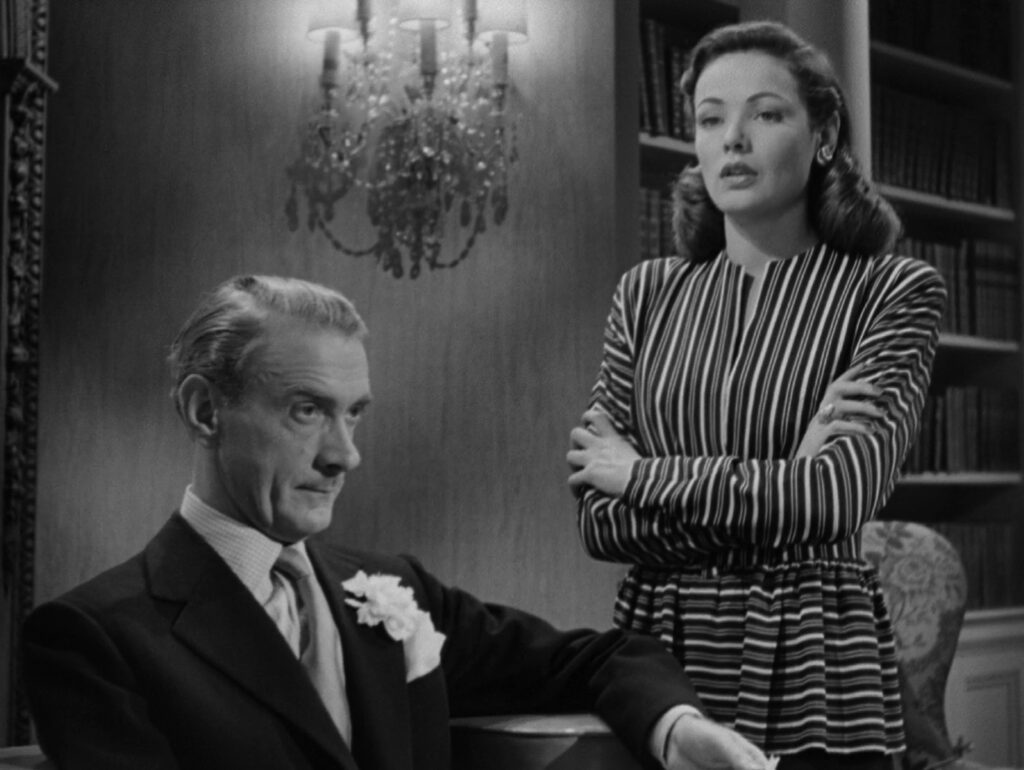
Laura
1944, directed by Otto Preminger
It’s a strange thing for a murder suspect to ask to tag along on an investigation, and stranger still for a detective to accommodate such a request. This unlikely turn occurs twice in the opening of Laura as Lieutenant McPherson gathers first Waldo Lydecker then Shelby Carpenter on his rounds. The three male leads form an odd trio, all rivals for Laura’s affection. If the investigation is like a journey, then the snowballing formation of this trio recalls the way Dorothy picked up the Scarecrow, Tin Man, and Lion in The Wizard of Oz, and it follows the same sequence. Nothing is ever said about McPherson’s brains, but he’s not witty like the other two, and as a detective he’s defined by what he doesn’t know. Lydecker tells Laura he’s “not without a heart” and offers an x-ray to prove it, but all signs point to his heartlessness. At the end Laura says Carpenter “hasn’t enough courage to kill a fly.”
These parallels aren’t extraordinary. To differentiate three characters along lines of mind, heart, and courage is common across literature and cinema, but the way these men come together, plus those two lines about “heart” and “courage”, suggests some awareness somewhere along the chain of script development. Whether Ann Treadwell fills the role of the Wicked Witch is less important than the one quality that motivates all these allusions. Like The Wizard of Oz, Laura is a journey through a realm of fantasy. The fantastic element here, as audiences of 1944 would have appreciated, is the wealth that defines almost all of the film’s settings.
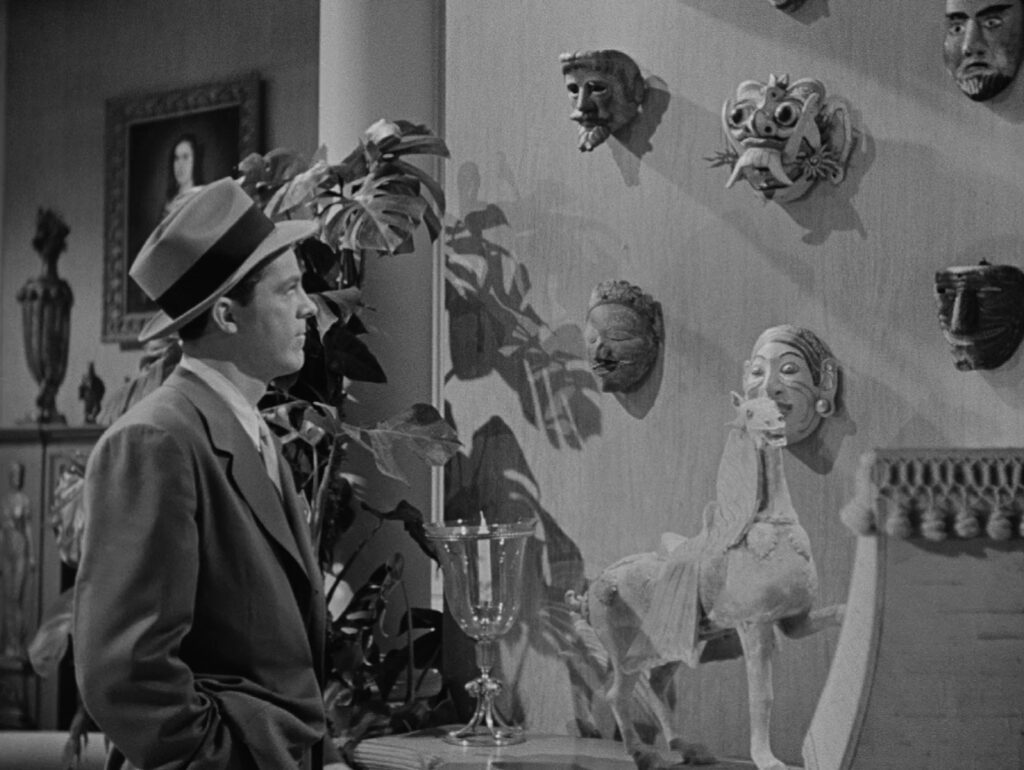
Laura opens onto a marvel of set design. Lydecker’s penthouse has a lofty ceiling, a furnished terrace, a creatively angled floor plan, countless exotic artifacts, and a skyline view from the marble bathtub where the lone inhabitant works at a typewriter. It’s all too much to pass without comment. “Nice little place you have here, Mr. Lydecker.” “It’s lavish, but I call it home.” The celebrity columnist might have put it differently, but he had to echo Dorothy’s last words.
The story will return to the penthouse only for brief intervals, but the remaining setpieces have a similar flavor: Mrs. Treadwell’s apartment, Laura’s home and country house, the venues of high society, Montagnino’s restaurant. Equally telling however are the momentary intervening flashes of everyday reality like the street scenes and police station. Everyone remarks on the plot twist when Laura appears just over halfway through, but the first scene ends with an equally abrupt visual shock. After the splendors of Lydecker’s ornate home, suddenly we’re confronted with a few seconds of spare geometry on a common sidewalk with a mailbox and lamppost as McPherson and Lydecker exit a taxi to visit Mrs. Treadwell. The next scene shift makes the point in a different way; instead of a visual contrast, the characters traverse a slice of humanity, a small crowd outside Laura’s home with policemen, drink vendors, and a paperboy shouting out the murder headline. These counterpoints to the prevailing opulence are not pictures of poverty but rather of plain, honest, ordinary life.
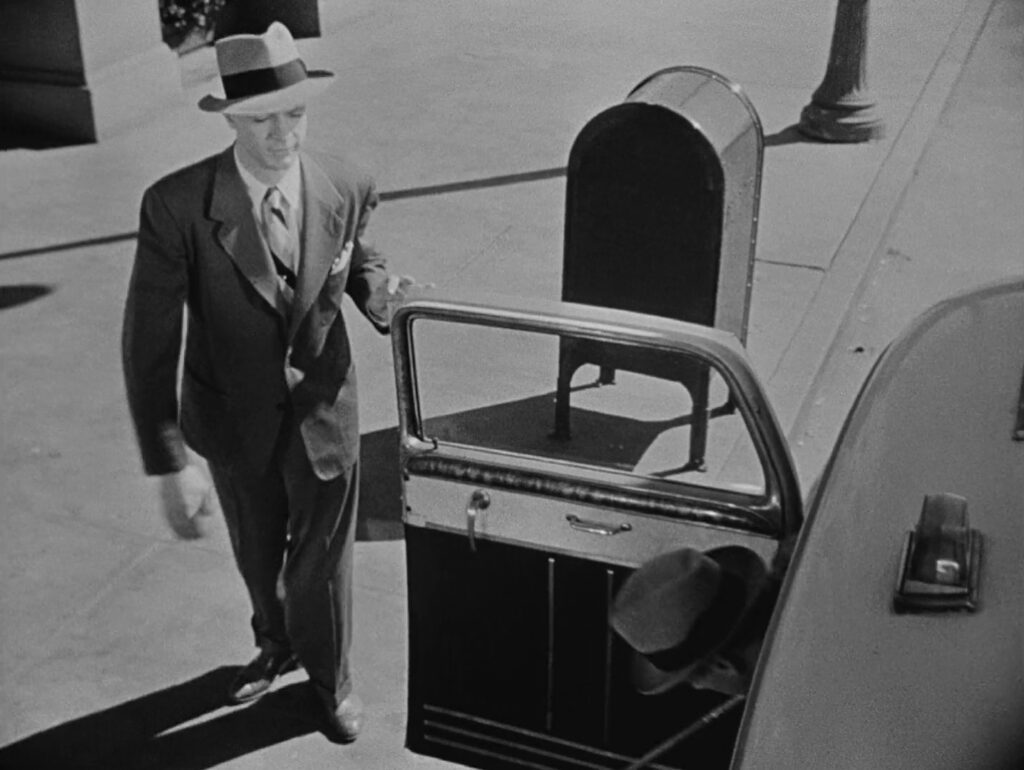
Apart from the film’s Academy Award-winning cinematography, none of this would strike viewers as any more extraordinary than the characterization of the three men. Films of the Depression and World War II were often set among the upper class, not only to relieve audiences from their bleak circumstances but also to assure them that the rich have problems too. The ethos of Roosevelt’s years looked askance at the profligacy of wealth, and Laura articulates the egalitarian values of the age about as well as any Hollywood film, at a time when the United States was consumed in a struggle against forces aligned with inequality. The frivolity of Lydecker’s materialistic self-absorption would not have sat well with most Americans back then.
Laura is a crime mystery, and Lydecker is not the only suspicious character. Mrs. Treadwell admits that both she and Shelby Carpenter are weak enough to be “capable of murder”. The crime might seem out of character for Laura, but if she wanted Shelby badly enough then jealousy would at least give her a motive. Even the maid, Bessie Clary, with her fanatical devotion to Laura, could have had a reason to kill Laura’s rival, but if we pick up on the film’s egalitarianism we know she has to be innocent. She’s too opposite to the dissolute wealth around her: “I’m a domestic, and I got nothin’ to be ashamed of.” The chief plot difficulty is that Lydecker is too obvious a villain for anyone who catches on early to the film’s outlook. It’s for this reason that the story needs the big plot twist. When Laura turns out to be alive after all, it pulls the rug out from under our suspicions, giving the film time to come back to the one character who has to be the killer – not only the richest character, but the one who most exemplifies the snobbery and entitlement of wealth.
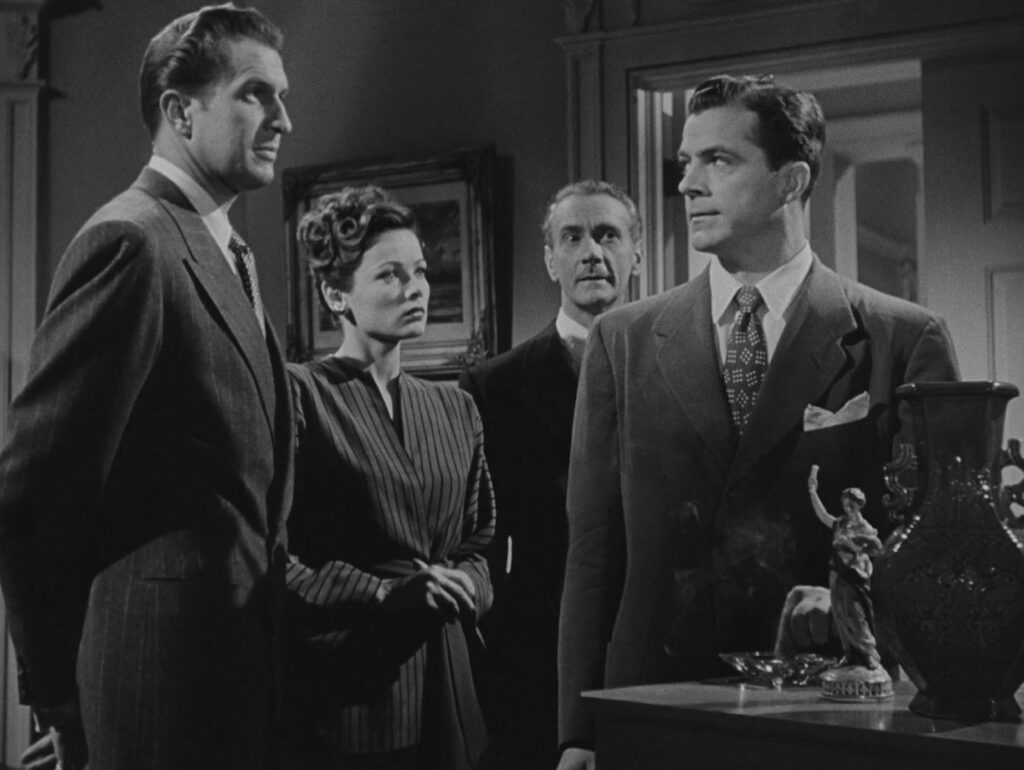
Mark McPherson of course is above suspicion, not only because he’s the detective but because he’s a paragon of middle-class ordinariness. Lydecker recognizes him as the heroic cop who brought down a newsworthy gangster, getting his leg shot up in the act, but at the height of World War II that kind of valor was supposed to be common to Americans. His surname sounds like “person” as if to stress his everyman credentials, and he irritates Lydecker with his miniature baseball toy and his colloquial language, calling women “dames” and “dolls”. He alone passes through the fantasy-land of excess wealth without belonging to it.
In this regard Laura is a lot like Dorothy. She belongs to the real world, coming from the stenographic department of an advertising firm, but through Lydecker she gains admission to the upper stratum of New York society. She may be tempted by what this exalted life offers her, but she’s never corrupted, and at the end she’s happy to choose McPherson from among all her suitors, returning to the mundane reality she came from.
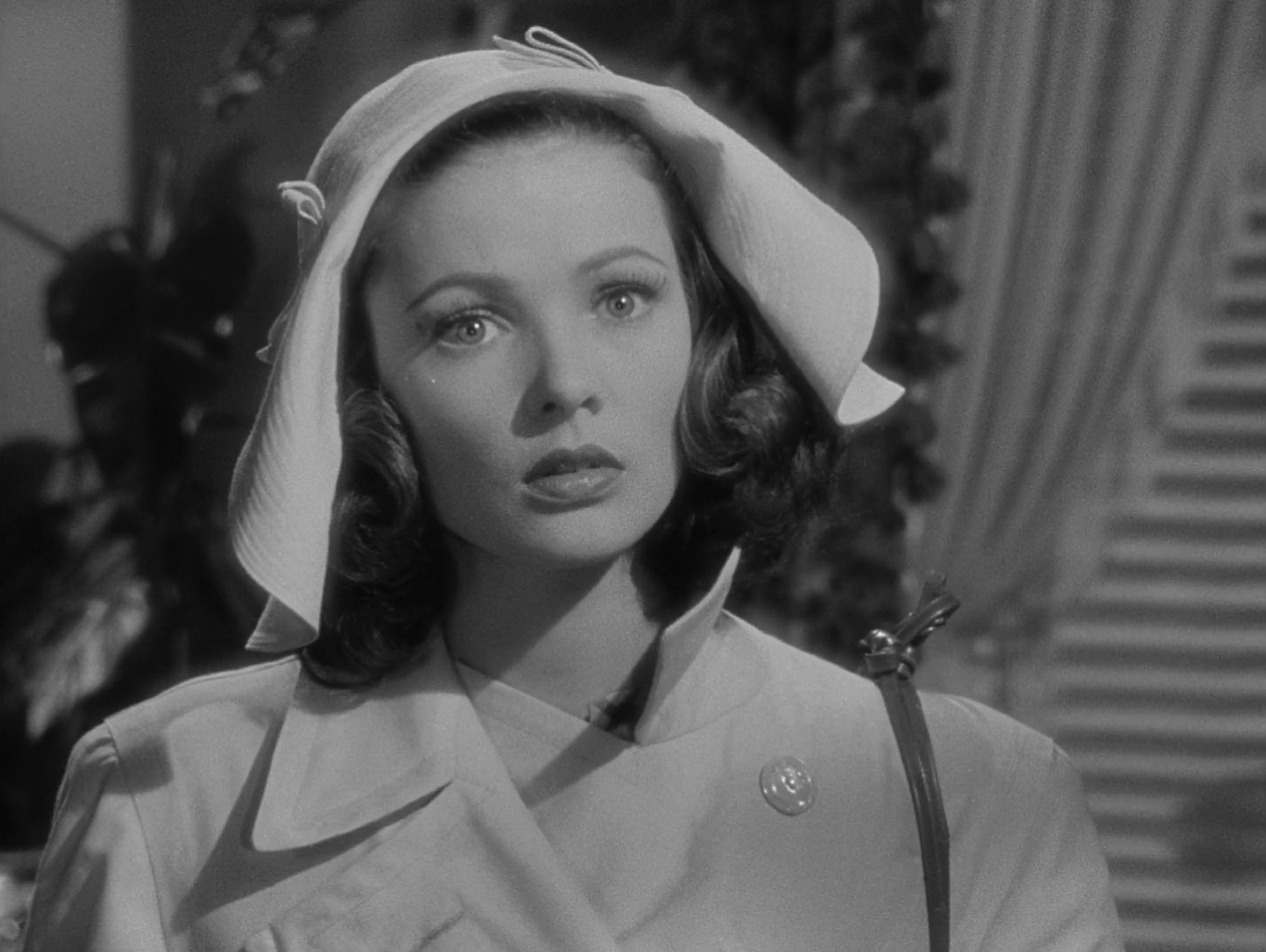
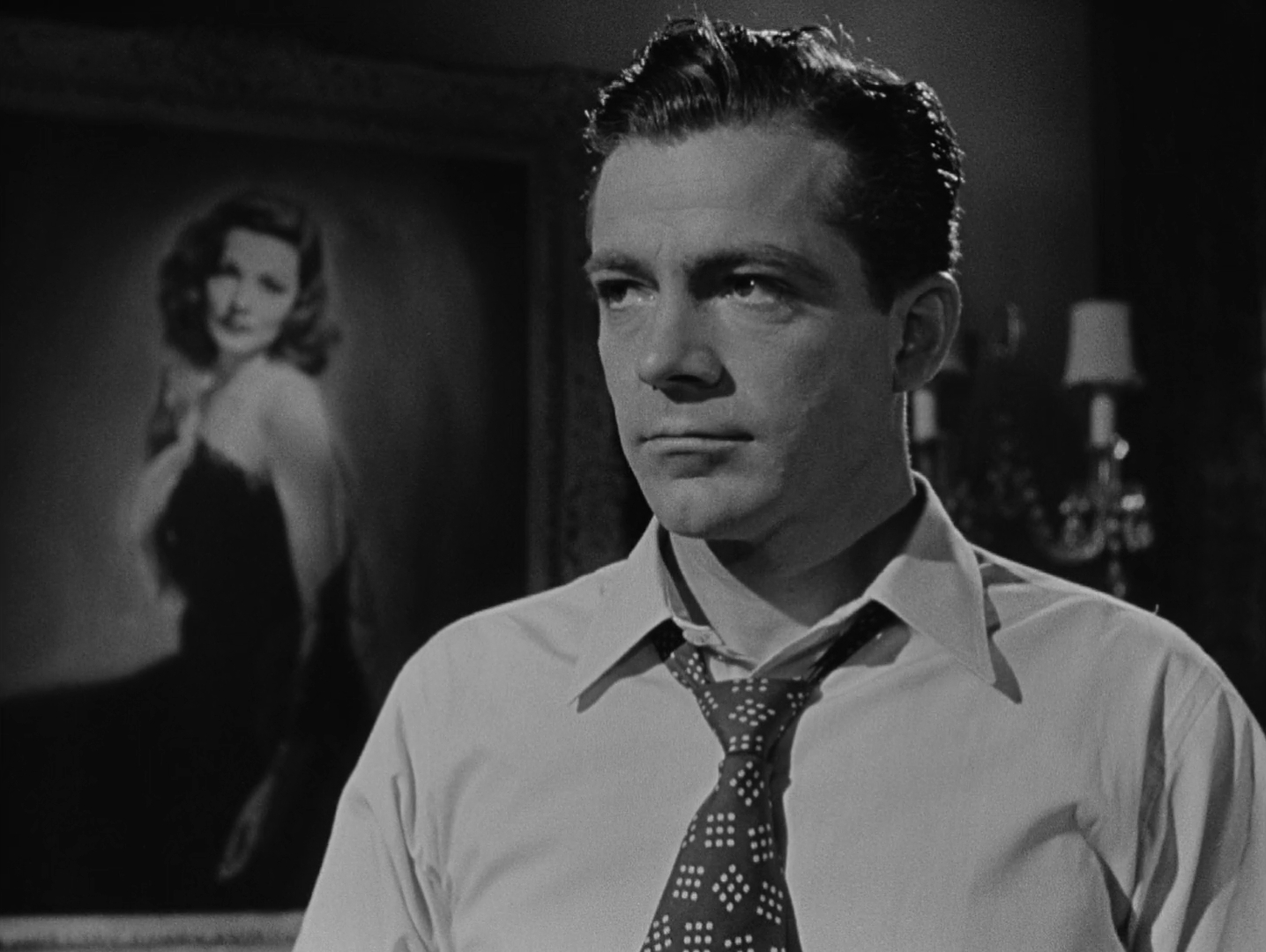
Laura may not be corrupted, but during her years with Lydecker she lives in a world that distorts ordinary relationships. The critique of wealth in Laura is not merely that it creates a fantasy divorced from real life, but that selfishness and inequality twist the loving and nurturing relationships that form the bedrock of a healthy society. Both Laura and Shelby are “kept” people, each involved with an older and wealthier person, each relationship tainted by a difference in power. Mrs. Treadwell feels Shelby belongs with her because of their shared faults, thus looking down on him as Shelby looks down on Laura when he assumes she’s guilty. Lydecker regards Laura as a possession, one of his visible hallmarks like his walking stick and white carnation. Bessie too is twisted, looking up at her mistress with an unhealthy reverence.
When Laura comes back from the dead, she saves McPherson from being drawn into his own twisted relationship, falling for the image of a woman he believed dead, even going so far as to place a bid on her oil portrait. As Lydecker tells Laura, “When you were unattainable, when he thought you were dead, that’s when he wanted you most.” Without denying the weirdness in this, Laura brushes it off: “But he was glad when I came back, as if he were waiting for me.” When McPherson had drifted off to sleep beside Laura’s portrait, the camera had closed in on him as if preparing for a dream, but it then pulled back, prefacing Laura’s surprise entrance and ending McPherson’s close shave with a perverse fantasy.
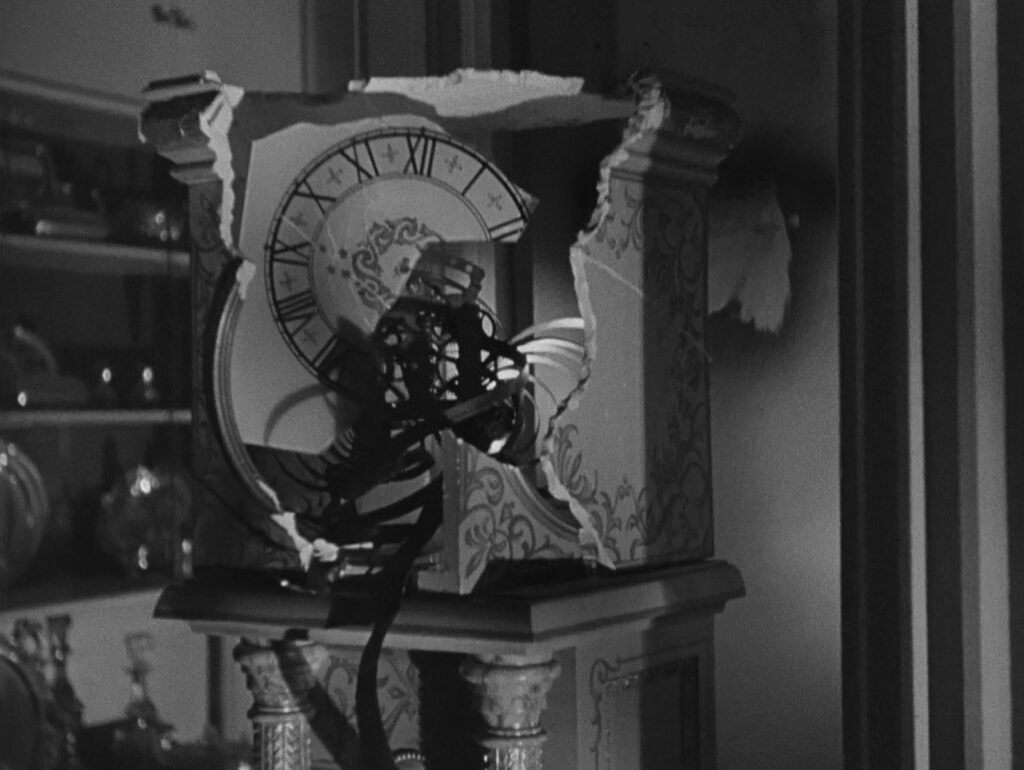
For Lydecker, as for countless wealthy people, this perversion is anything but a close shave. It destroys him, and the film teaches us to look at wealth as a kind of sickness. The first image, appropriately, is an idol decorating his penthouse, but the shot immediately pans to the ornate floor clock, one of a pair that’s closely identified with Lydecker. A clock represents time, and by extension, life. These clocks have a secret compartment, just as he has a secret, but the chamber has nothing inside but a shotgun. His life is showy but hollow, a mechanical instrument like a Tin Man without a heart, and in his last act Lydecker misses his target, shattering the clock and effectively destroying himself as he’s been doing all along.
CONNECTIONS:
The Wizard of Oz – Physical or figurative journey through an exalted world; trio of men lacking intellect, heart, and courage; innocent young woman from a humble background
Rebecca – Servant fanatically devoted to her mistress; critique of a class system; important role given to a woman’s portrait; woman’s first name as title
Vertigo – Character who seems oddly fixated on a painted portrait; woman who comes back from presumed death, identified by a recurring musical theme
The Servant – Critique of a class system; clock in the final image